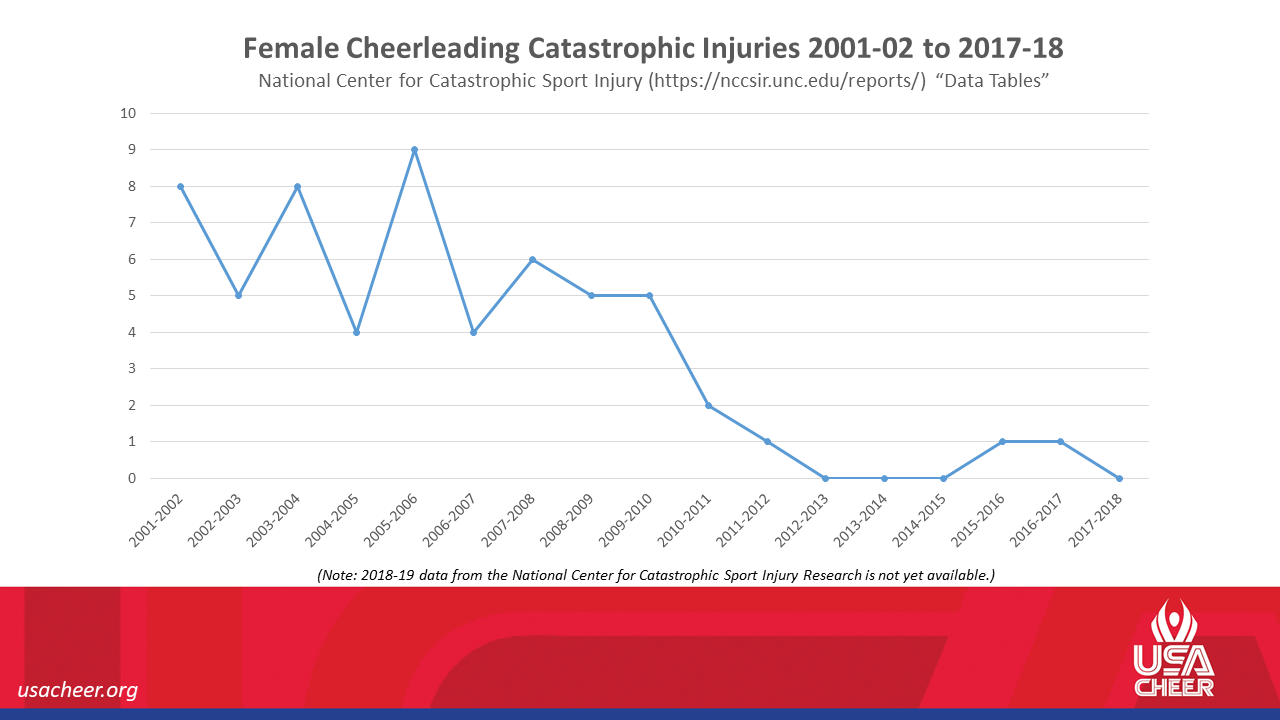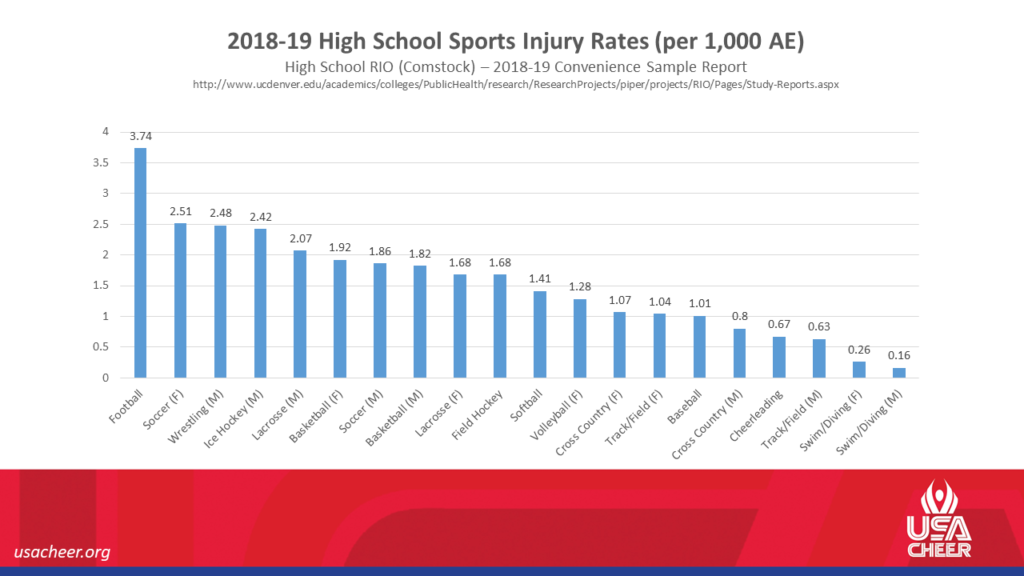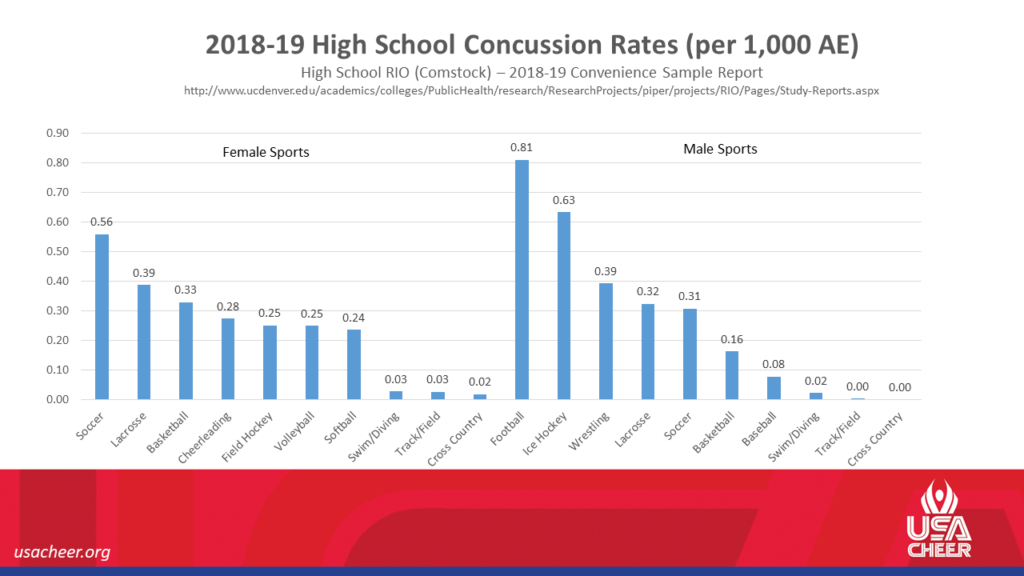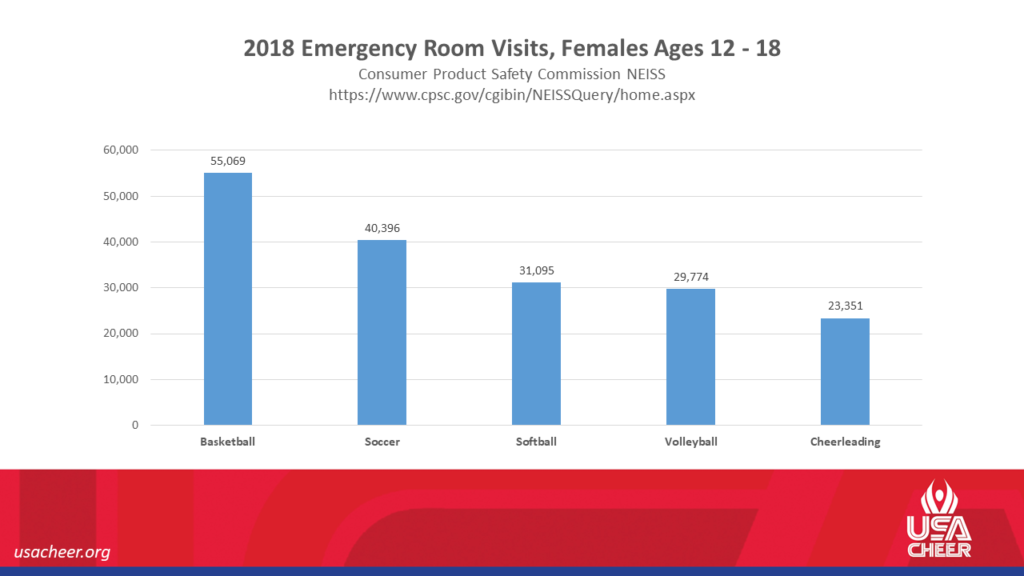STUNT Safety and Risk Management
STUNT Risks
All sports have inherent risks. STUNT involves athletes participating in partner stunts, pyramids, tosses, jumps, and tumbling. These skills include height, inversion, and rotation of the body as well as working in coordination with other athletes to perform these skills. Special care should be taken by supervisory staff to ensure that skills are taught in a progressive manner, requiring proficiency before advancing to skills with higher difficulty.
The Myth of Cheerleading Injuries
As STUNT is based on the skills found in cheerleading, one of the first issues to address is the unfounded perception that cheerleading is somehow more dangerous than other sports, including football.
Without getting into details for the purposes of this article, many years ago a news article from Yahoo Sports inadvertently left off an important piece of information in a report it presented. It said that cheerleading had 67% of catastrophic injuries in all sports. The key mistake there is that the data was only of female sports, which have a significantly lower number of injuries than males sports. This mistake was then copied by the 300+ outlets that cited Yahoo Sports, including false headlines such as “Cheerleading is more dangerous than football”, obviously leading to the misperception that cheerleading is more dangerous than football. Yahoo updated their article, but few of the outlets that shared the information did. The data is simply not supported.
Additionally, even within cheerleading, the number of catastrophic injuries has been reduced dramatically over the past decade (see Chart 1 below). Very few news outlets have decided to share this information, leaving an information gap that still purports that cheerleading is dangerous.

Chart 1 – Cheer Catastrophic Injuries by Year
Further, an ongoing 10-year study by the National Federation of High Schools has included cheerleading in its reporting, and throughout this study, cheerleading has ranked amongst the safest of the 20 sports studied in terms of injury rates, coming in 4th safest in the latest 2019 study (See Chart 2 below). In the same study, cheerleading shows a lower concussion rate than 8 other sports, including women’s soccer, lacrosse, and basketball (See Chart 3 below).

Chart 2 – High School Sports Injury Rates |

Chart 3 – High School Sports Concussion Rates |
Finally, cheerleading emergency room visits are lower than several female sports, though the cheerleading figures are often cited in articles without any mention of these other sports for any type of perspective (See Chart 4 below).
 Chart 4 – Emergency Room visits by females ages 12-18
Chart 4 – Emergency Room visits by females ages 12-18
All of the available cheerleading injury data can be found at https://www.usacheer.org/safety/research
What has STUNT done to minimize risk?
The format of the STUNT game vs. cheerleading leads to an even further decrease in risk.
In a cheerleading competition, teams are allowed to perform any skills within the allowed rules structure. This includes making up new skills and attempting the most difficult skills allowed, regardless of ability level. All athletes are on the floor at the same time, attempting to perform the most difficult skills they can perform in order to gain points. Scoring is based on execution and difficulty, Coaches training includes risk minimization, and penalties for falls help encourage teams to stay within their ability levels.
How the STUNT format minimizes risk:
- In a STUNT game, teams perform pre-choreographed compulsory routines. There is no “making up new skills” to see who can come up with the most difficult and creative skill. Since each team is performing the same routine at the same time, difficulty is not considered in scoring. Technique and execution of skills is rewarded in the scoring system.
- Skill modification is allowed, which gives the coach the opportunity to substitute an easier skill that will result in a smaller penalty than if the skill failed and created a safety issue. As the season progresses and individual skills get better, they may change the skill back to the original skill. This format encourages coaches to take the safer option.
- The routines in each quarter are focused on a specific area of skills; quarter 1 is Partner Stunts, quarter 2 is Pyramids and Tosses, and quarter 3 is Jumps and Tumbling. The 4th quarter puts those routines back-to-back in a longer format, but utilize the same compulsory routines. What this means is that an athlete who is good at building or spotting partner stunts is not pushed to also perform tumbling skills. Likewise, an athlete with a gymnastics background can be used for the Jumps and Tumbling quarter, but does not have to build stunts or pyramids. A comparison would be using specialized athletes on a kickoff or receiving team that may not participate in other parts of the game.
- Each of the routines in the quarters involves a different level of difficulty. Lower-numbered routines have an easy difficulty level, which progresses steadily up to the higher-numbered routines with more difficulty. This format allows a coach to place athletes in routines that fit their ability level. Newer athletes may be involved in lower-numbered routines while more experienced and talented athletes participate in higher-numbered routines.
- A team can forfeit a round. If a team determines that a higher-level routine is beyond their difficulty level and that performing it would be unsafe, they can simply forfeit that round. The opposing team would get the point, and the forfeiting team gains possession – the ability to determine which level of the routines will be played next. This not only keeps her team from being in an unsafe position, it allows her to call a routine that fits her team’s ability level for the next round.
In addition to the game format, STUNT coaches are required to complete the USA Cheer Safety and Risk Management Course, which is required of all NCAA cheerleading coaches and most state high school athletics associations who require coaches’ sport-specific training. They are also trained on the rules and regulations of STUNT, including the coaching strategies outlined above that can reduce risk while factoring into their overall game strategy.
The STUNT format has shown positive results
| Sport | Game | Practice | Source |
| STUNT | 0.46(1) | 0.89(2) | See below |
| Soccer | 5.2 | 16.4 | https://www.ncbi.nlm.nih.gov/pmc/articles/PMC1941298 |
| Basketball | 3.99 | 7.68 | https://www.ncbi.nlm.nih.gov/pmc/articles/PMC1941290 |
| Gymnastics | 6.07 | 15.19 | https://www.ncbi.nlm.nih.gov/pmc/articles/PMC1941288 |
1) The STUNT game data above was collected from Athletic Trainer reports collected from STUNT games from 2010-2015.
2) A 2016-17 Injury Survey was sent to coaches to include practices and games to determine practice injury rates. The game data collected from athletic trainers in 2010-15 supports data collected from coaches in 2016-17 (0.46 AE vs 0.42 AE), which provides some level of confidence in the coach reporting of practice injury rates.
As STUNT is a new sport, it has not been included in external formalized studies or the NFHS or NCAA Injury Surveillance System up to this point.
A more formalized reporting system was put in place for the 2020 season, but due to the COVID-19 pandemic, was not able to be utilized. We are looking forward to implementing this system in the upcoming 2021 season.
